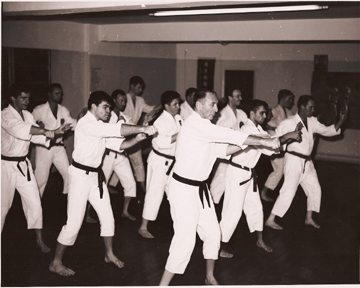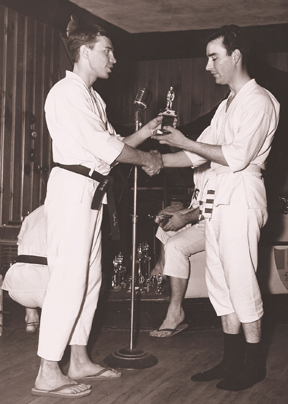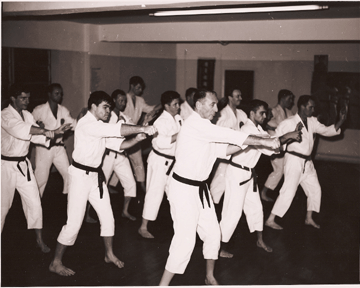“Reality” check from George Mattson’s “Swamp” dojo!
 I’m going to tackle a subject that I’ve covered many times in the past. Although most of my students and many of my associates clearly understand my position on the subject, others continue to hammer away blissfully, shadowboxing with words and rallying enthusiastically against a foe that only exists in their minds.
I’m going to tackle a subject that I’ve covered many times in the past. Although most of my students and many of my associates clearly understand my position on the subject, others continue to hammer away blissfully, shadowboxing with words and rallying enthusiastically against a foe that only exists in their minds.
What exactly is the problem that eats away at them so that at every opportunity they must spend so much time ranting on and on and on how the traditional Uechi dojo are corrupting the minds and bodies of their students with excessive, obsolete and harmful drills, exercises, kata (that they don’t like) and how dojo that actually have students are endangering these students’ lives by teaching Uechi-ryu in a manner that these “guardians” of the “correct” system dislike!
Uechi-ryu, like most sports has evolved since the early 1900s. What sport hasn’t? Unlike other sports, Uechi-ryu was a very effective system of self defense instead of a competitive activity. It was also based on ancient Chinese folk-art that purported to pass on to the student other benefits:
1. Was a healthful activity
2. Came with a moral code of ethics and conduct
3. Was not something to be taught to bullies or criminals.
4. Was to be used only in self-defense
5. Was to be transmitted in a careful manner as to not hurt students
6. Was not to be misused in a boastful manner (Don’t “showoff”)
When Kanei Uechi agreed to let Tomoyose Sensei teach me Uechi-ryu, he made me promise to introduce Uechi-ryu to people outside of Okinawa and to teach it as I learned it.
I interpreted this promise to mean teaching the system’s core values, since Uechi Sensei added material to the basic system and in subsequent visits to Okinawa, I came to realized that the system was quite adaptable to fit the needs of changing times, environments and individuals. Unlike my early attempts to make every student a carbon copy of me, I realized that teaching Uechi-ryu was itself an art. . . being able to adapt a physical art to fulfill the requirements of as many people as possible. . . not just those who had my stamina, build, abilities and motivation. With the new tools of the art that I picked up on subsequent trips, I was able to create a program that worked for nearly everyone who shared a commonality of incentive for seeking out my dojo and wanting to learn karate.
The success of my school during the 60s – 80s was simple:
1. I was the first, with a mysterious and misunderstood activity that everyone wanted to learn.
2. I created a new way (at the time) to teach Uechi-ryu, enabling my school to grow quite large.
3. I was able to create different groups within the dojo. . . each focusing on what they needed, while maintaining a core program that all groups shared
The third category proved to be both a creative fix for an ancient tool and an escape valve for those who wished to focus all their attention on one of these offshoot activities. Although my school retained more students than any other dojo during this time period, I lost many students to religious cults, TaiChi, Full contact sports that were making their appearance during this time and others found judo/jiujitsu more to their liking.
 Many others enjoyed the sport aspect of karate and early on I created sport tournament rules and conducted frequent tournaments for this group of students. (The 1st tournament in North America I believe was mine, conducted at the Bavarian Houfbrau in the early 60s) This group remained loyal to the core program of Uechi, and because of my policy of encouraging creativity and working “outside of the box”, the sport of Uechi followed the general karate philosophy of: my style of sparring is “what works”, meant what was seen in training and in matches had little resemblance to the core system.
Many others enjoyed the sport aspect of karate and early on I created sport tournament rules and conducted frequent tournaments for this group of students. (The 1st tournament in North America I believe was mine, conducted at the Bavarian Houfbrau in the early 60s) This group remained loyal to the core program of Uechi, and because of my policy of encouraging creativity and working “outside of the box”, the sport of Uechi followed the general karate philosophy of: my style of sparring is “what works”, meant what was seen in training and in matches had little resemblance to the core system.
Essentially, sport Uechi and the art of Uechi were entirely different. Those of us in Uechi-ryu were fooling ourselves by trying to “jury-rig” the evolving style together by conducting tournaments where kata and kumite were being performed, but in reality, sport karate was moving in a direction that could never be rehabilitated.
Sport karate was pretending to be “reality” based, but wasn’t. The “art” of karate was also pretending to be “reality” based, but wasn’t. And this is the problem we are faced with today!
Right now there are three “groups” of teachers within Uechi-ryu. . . well, maybe four.
1. The largest groups who say, “I know what I am doing isn’t the perfect self-defense method, but I’m doing an activity I enjoy and for the time spent, the self-defense skills are a bonus.”
2. The smallest group are those who evolved from the sports group who remained loyal to the Uechi system. They wish to find justification for continuing to practice the Uechi core system while pretending that what they are doing will increase their survival chances in a real fight more than group 1. They don’t have many students, because those students who really want to accomplish what these teachers promise, will not waste their time doing kata. They will go to someone who specializes in fighting! Or weapon usage? Or “Verbal Self Defense” courses. So these teachers waste much time attempting to convert the members of the first group (those who have students) to stop doing what they are doing (that the students enjoy). By now, hopefully you are asking “Why are they doing this?”
3. This third group is unique and I admire their dedication. They religiously practice what their original teachers on Okinawa taught them; considering their entire program the “core” system. They also believe that what they are doing will work if needed. Few students, but they steadfast “stay the course”.
4. This last group wants to study “Kanbun’s Way” and this is their goal over and above anything else. They are dedicated and religiously are preserving what they believe to be the original system.
All this is a long-winded introduction to the following statement:
“Fighting is a multi-dimensional activity. It is continually evolving and if someone is truly interested, motivated and willing to do the hard work necessary to become proficient in fighting, I would not recommend going to a traditional karate dojo or for that matter to any martial art dojo!”
In the way of an explanation, I offer these comments:
1. What I taught in the 60s was “state of the art”. . . as it was in China, Okinawa and Japan prior to the 20th century. It is not “state of the art” today!
2. What I teach now is “The Art of Uechi-ryu” that happens to use self-defense technique, drills and applications along with common sense fitness recommendations. It is a very physical system, super organized and interesting. Students love it and the program fulfills the goals I’ve established. I continue to encourage students to supplement their “core” training with compatible methods that will fulfill long-term goals. (weapon usage, “realist” fighting skills, police/military skills etc.) I don’t try to fool my students into believing they are army rangers, Navy Seals or Ultimate Fighters because they are Uechi black belts.
3. My goal as a teacher is to provide a permanent place in society for an activity called Uechi-ryu. This goal has been reasonably successful for the past 50 years and in this format, will continue to remain popular.
My goals in Uechi-ryu have changed a great deal over the years. I no longer envision a unified Uechi-ryu nor even a system with a common “core” system. There are too many really bad dojo out there for this to ever happen.
Teachers and dojo that accommodate many people by providing an honest service will survive and prosper. Those that don’t will fall by the wayside.
If you can identify with one of the aforementioned groups, please be happy with what you are doing. If you are one of the individuals who is on a mission from god to convert all us “traditionalist”. . . well, save your time and energy. Spend it finding a few students who will listen to you and teach them everything you know. Of course, the rest of us will be happy to hear your progress reports.
Happy New Year. . . I’m off to the dojo to work out!


